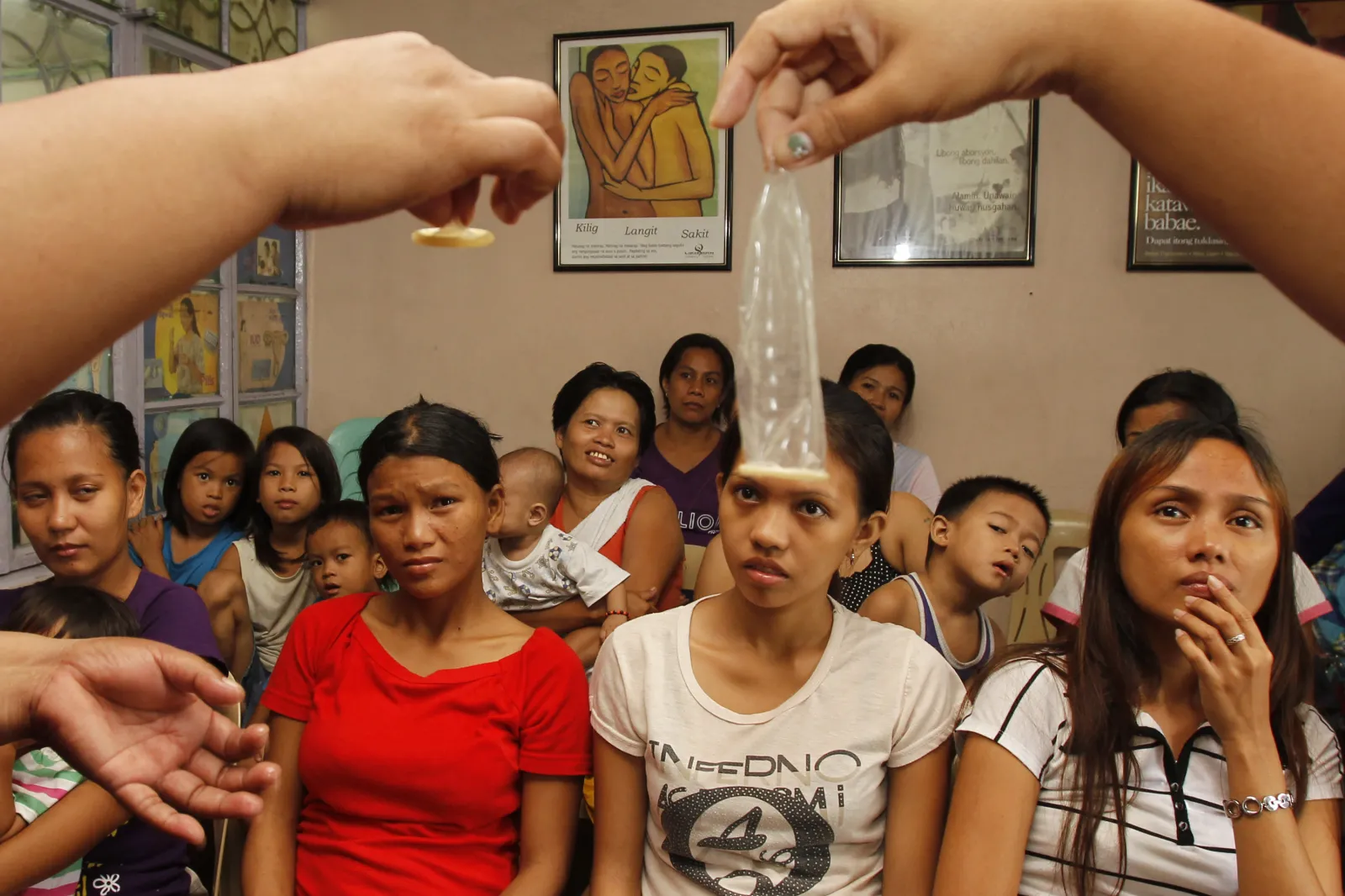S*xuality Education

Table of Contents
Building an evidence- and rights-based approach to healthy decision-making in s*x Education
As they grow up, young people face important decisions about relationships, s*xuality, and s*xual behavior. The decisions they make can impact their health and well-being for the rest of their lives. Young people have the right to lead healthy lives, and society has the responsibility to prepare youth by providing them with comprehensive s*xual health education that gives them the tools they need to make healthy decisions. But it is not enough for programs to include discussions of abstinence and contraception to help young people avoid unintended pregnancy or disease. Comprehensive s*xual health education must do more. It must provide young people with honest, age-appropriate information and skills necessary to help them take personal responsibility for their health and overall well being. This paper provides an overview of research on effective s*x education, laws and policies that shape it, and how it can impact young people’s lives.
What is s*xual health education?
S*x education is the provision of information about bodily development, s*x, s*xuality, and relationships, along with skills-building to help young people communicate about and make informed decisions regarding s*x and their s*xual health. S*x education should occur throughout a student’s grade levels, with information appropriate to students’ development and cultural background. It should include information about puberty and reproduction, abstinence, contraception and condoms, relationships, s*xual violence prevention, body image, gender identity and s*xual orientation. It should be taught by trained teachers. S*x education should be informed by evidence of what works best to prevent unintended pregnancy and s*xually transmitted infections, but it should also respect young people’s right to complete and honest information. S*x education should treat s*xual development as a normal, natural part of human development.
Why is s*xual health education important to young people’s health and well-being?
Comprehensive s*xual health education covers a range of topics throughout the student’s grade levels. Along with parental and community support, it can help young people:
- Avoid negative health consequences. Each year in the United States, about 750,000 teens become pregnant, with up to 82 percent of those pregnancies being unintended. Young people ages 15-24 account for 25 percent of all new HIV infections in the U.S. and make up almost one-half of the over 19 million new STD infections Americans acquire each year. S*x education teaches young people the skills they need to protect themselves.
- Communicate about s*xuality and s*xual health. Throughout their lives, people communicate with parents, friends and intimate partners about s*xuality. Learning to freely discuss contraception and condoms, as well as activities they are not ready for, protects young people’s health throughout their lives. Delay s*xual initiation until they are ready. Comprehensive s*xual health education teaches abstinence as the only 100 percent effective method of preventing HIV, STIs, and unintended pregnancy – and as a valid choice which everyone has the right to make. Dozens of s*x education programs have been proven effective at helping young people delay s*x or have s*x less often.
- Understand healthy and unhealthy relationships. Maintaining a healthy relationship requires skills many young people are never taught – like positive communication, conflict management, and negotiating decisions around s*xual activity. A lack of these skills can lead to unhealthy and even violent relationships among youth: one in 10 high school students has experienced physical violence from a dating partner in the past year.[6] S*x education should include understanding and identifying healthy and unhealthy relationship patterns; effective ways to communicate relationship needs and manage conflict; and strategies to avoid or end an unhealthy relationship.
- Understand, value, and feel autonomy over their bodies. Comprehensive s*xual health education teaches not only the basics of puberty and development, but also instills in young people that they have the right to decide what behaviors they engage in and to say no to unwanted s*xual activity. Furthermore, s*x education helps young people to examine the forces that contribute to a positive or negative body image.
- Respect others’ right to bodily autonomy. Eight percent of high school students have been forced to have intercourse[8], while one in ten students say they have committed s*xual violence. Good s*x education teaches young people what constitutes s*xual violence, that s*xual violence is wrong, and how to find help if they have been assaulted.
- Show dignity and respect for all people, regardless of s*xual orientation or gender identity. The past few decades have seen huge steps toward equality for lesbian, gay, bis*xual, and transgender (LGBT) individuals. Yet LGBT youth still face discrimination and harassment. Among LGBT students, 82 percent have experienced harassment due to the s*xual orientation, and 38 percent have experienced physical harassment.
- Protect their academic success. Student s*xual health can affect academic success. The Centers for Disease Control and Prevention (CDC) has found that students who do not engage in health risk behaviors receive higher grades than students who do engage in health risk behaviors. Health-related problems and unintended pregnancy can both contribute to absenteeism and dropout.
What does the research say about effective s*x education?
- Comprehensive s*xual health education works. Research has repeatedly found that s*x education which provides accurate, complete, and developmentally appropriate information on human s*xuality, including risk-reduction strategies and contraception helps young people take steps to protect their health, including delaying s*x, using condoms or contraception, and being monogamous.
- A 2012 study that examined 66 comprehensive s*xual risk reduction programs found them to be an effective public health strategy to reduce adolescent pregnancy, HIV, and STIs.
- Research from the National Survey of Family Growth assessed the impact of s*xuality education on youth s*xual risk-taking for young people ages 15-19 and found that teens who received comprehensive s*x education were 50 percent less likely to experience pregnancy than those who received abstinence-only-until-marriage programs.
- Even accounting for differences in household income and education, states which teach s*x education and/or HIV education that covers abstinence as well as contraception, tend to have the lowest pregnancy rates.
- National S*xuality Education Standards provide a roadmap. The National S*xuality Education Standards, developed by experts in the public health and s*xuality education field and heavily influenced by the National Health Education Standards, provide guidance about the minimum essential content and skills needed to help students make informed decisions about s*xual health. The standards focus on seven topics as the minimum, essential content and skills for K–12 education: Anatomy and Physiology, Puberty and Adolescent Development, Identity, Pregnancy and Reproduction, S*xually Transmitted Diseases and HIV, Healthy Relationships, and Personal Safety. Topics are presented using performance indicators—what students should learn by the end of grades 2, 5, 8, and 12. Schools which are developing comprehensive s*xual health education programs should consult the National S*xuality Education Standards to provide students with the information and skills they need to develop into healthy adults.
- Evidence-based interventions are proven effective for schools serving communities at risk.Schools may wish to embed evidence-based interventions (EBIs) in their s*xual health education programs. Others may wish to provide EBIs as targeted interventions for groups of students at high risk. To do the latter, these programs should be provided in an after school setting. Researchers have identified dozens of EBIs where participants showed statistically significant declines in teen pregnancy, HIV, or other STIs. Following are collections of EBIs targeting youth from a variety of backgrounds.
- Science and Success:Programs that Work to Prevent Teen Pregnancy, HIV, and S*xually Transmitted Infections (Advocates for Youth, 2012): Advocates for Youth undertook exhaustive reviews of existing programs that work to prevent teen pregnancy, HIV, and STIs and compiled a list of programs that have been proven effective by rigorous evaluation. Thirty-six effective programs were identified.[5]
- 16 programs demonstrated a statistically significant delay in the timing of first s*x.
- 21 programs showed statistically significant declines in teen pregnancy, HIV or other STIs.
- 16 programs helped s*xually active youth to increase their use of condoms.
- 9 programs demonstrated success at increasing use of contraception other than condoms.
- Emerging Answers(The National Campaign to End Teen and Unplanned Pregnancy, 2007): Researcher Douglas Kirby examined studies of prevention programs which had a strong experimental design and used other appropriate analysis criteria. Two-thirds of the 48 comprehensive s*x education programs studied had positive effects:
- 40 percent delayed s*xual initiation, reduced number of s*xual partners, or increased condom or contraceptive use;
- 30 percent reduced the frequency of s*x, including return to abstinence; and
- 60 percent reduced unprotected s*x.
- The Office of Adolescent Health, a division of the U.S. Department of Health and Human Services, keeps a list of evidence-based interventions, with ratings based on the rigor of program impact studies and strength of the evidence supporting the program model. Thirty-one programs meet the OAH’s effectiveness criteria and that were found to be effective at preventing teen pregnancies or births, reducing s*xually transmitted infections, or reducing rates of associated s*xual risk behaviors (defined by s*xual activity, contraceptive use, or number of partners).
- Science and Success:Programs that Work to Prevent Teen Pregnancy, HIV, and S*xually Transmitted Infections (Advocates for Youth, 2012): Advocates for Youth undertook exhaustive reviews of existing programs that work to prevent teen pregnancy, HIV, and STIs and compiled a list of programs that have been proven effective by rigorous evaluation. Thirty-six effective programs were identified.[5]
What’s wrong with abstinence-only-until-marriage programs?
Many students receive abstinence-only-until marriage programs instead of or in addition to more comprehensive programs. These programs:
- Depict abstinence until heteros*xual marriage as the only moral choice for young people
- Mention contraception only in terms of failure rates
- Focus on heteros*xual youth, ignoring the needs of LGBTQ youth
- Often use outdated gender roles, urging “modesty” for all girls while painting all boys as s*xual aggressors.
- Have been found to contain false information
- Are not supported by the majority of Americans.
Only one abstinence-only program has ever been proven effective at helping young people delay s*x; yet in withholding information about contraception, it leaves those who do have s*x completely at risk. Studies show that 99 percent of people will use contraception in their lifetimes,[20] and that the provision of information about contraception does not hasten the onset of s*xual debut or increase s*xual activity.[10] Meanwhile, thirty years of public health research clearly demonstrate that comprehensive s*x education can help young people delay s*xual initiation while also assisting them to use protection when they do become s*xually active. We want young people to behave responsibly when it comes to decisions about s*xual health, and that means society has the responsibility to provide them with honest, age-appropriate comprehensive s*xual health education; access to services to prevent pregnancy and s*xually transmitted infections; and the resources to help them lead healthy lives.
All young people need comprehensive s*xual health education, while others also need s*xual health services. Youth at disproportionate risk for s*xual health disparities may also need targeted interventions designed specifically to build self efficacy and agency. Further, administrators and other policy makers must recognize that structural determinants, socio-cultural factors and cultural norms have been shown to have a strong impact on youth s*xual health and must be tackled to truly redress s*xual health disparity fueled by social inequity.
How is the content of a student’s s*x education decided?
Many factors help shape the content of a student’s s*x education. These include:
- State and federal funding the school district receives
- State laws and standards regarding s*x education
- School district level policies and/or standards regarding curricula and content
- The program or curriculum a district or individual school selects
- The individual(s) who delivers the program.
With thousands of school districts around the nation, students’ experiences can vary drastically from district to district and school to school.
What are federal, state, and local structures that affect s*x education?
In the United States, education is largely a state and local responsibility, as dictated by the 10th Amendment of the U.S. Constitution. This amendment states that “the powers not delegated to the United States by the Constitution, nor prohibited by it to the States, are reserved to the States respectively, or to the people.” Because the Constitution doesn’t specifically mention education, the federal government does not have any direct authority regarding curriculum, instruction, administration, personnel, etc. In 1980, the U.S. Department of Education was created. While this move centralized federal efforts and responsibilities into one office, it did not come with an increase in federal jurisdiction over the educational system.
The U.S. Department of Education currently has no authority over s*xual health education. However, there have been federal funds allocated, primarily through the Department of Health and Human Services that school systems and community-based agencies have used throughout the last three decades to provide various forms of s*x education.
- Federal funding: Until FY2010, there was no designated funding for a comprehensive approach to s*x education. In 1982, federal support of abstinence-only programs began, and in 1996, expanded drastically. From 1996-2010, over $1.5 billion in federal funding went to abstinence-only programs, which were conducted with little oversight and were proven ineffective. While one large stream of funding for abstinence-only programs was cancelled in 2010, at publication one still exists (as authorized by Congress through Title V funding) and is funded at $50 million per year.
In 2010, two streams of funding became available for evidence-based s*x education interventions.
- PREP: The Personal Responsibility Education Program (PREP) was authorized by Congress as a part of the Affordable Care Act of 2010. PREP provides grants ($75 million over five years) for programs which teach about both abstinence and contraception in order to help young people reduce their risk for unintended pregnancy, HIV, and STIs. In Fiscal Year 2012, 45 states applied for PREP. PREP grants are issued to states, typically the state health departments. All programs implemented with PREP funding are to educate adolescents about both abstinence and contraception for the prevention of pregnancy and STIs, including HIV/AIDS, and must cover at least three adulthood preparation subjects such as healthy relationships, adolescent development, financial literacy, educational and career success, and healthy life skills.
- The President’s Teen Pregnancy Prevention Initiative (TPPI) funds medically-accurate and age-appropriate programs to reduce teen pregnancy. Seventy-five grantees in 32 states received TPPI funds in FY 2012. TPPI grants are distributed by the Office of Adolescent Health to local public and private entities. Grantees must implement an evidence-based program which has been proven effective at preventing teen pregnancy. According to OAH, 31 programs meet these criteria, including one abstinence-only-until-marriage program.
- States may accept PREP, TPPI, or Title V funds. Many states accept funds for both abstinence-only programs and evidence-based interventions. In 2013, 19 SEAs and 17 LEA received five year cooperative agreements from CDC/DASH to implement ESHE within their school systems.
In addition, in 2013, CDC/Division of School Health issued a request for proposals to fund State Education Agencies (SEAs) and Large Municipal Education Agencies (LEAs) to implement Exemplary S*xual Health Education (ESHE). ESHE is defined as a systematic, evidence-informed approach to s*xual health education that includes the use of grade-specific, evidence-based interventions, but also emphasizes sequential learning across elementary, middle, and high school grade levels.
States may accept PREP, TPPI, or Title V funds. Many states accept funds for both abstinence-only programs and evidence-based interventions. In 2013, 19 SEAs and 17 LEAs received five year cooperative agreements from CDC/DASH to implement ESHE within their school systems.
- The Real Education for Healthy Youth Act: While there is as yet no law that supports comprehensive s*xual health education, there is pending legislation. The Real Education for Healthy Youth Act (S. 372/H.R. 725), introduced in February 2013 by the late Senator Frank Lautenberg (D-NJ) and Representative Barbara Lee (D-CA), would ensure that federal funding is allocated to comprehensive s*xual health education programs that provide young people with the skills and information they need to make informed, responsible, and healthy decisions. This legislation sets forth a vision for comprehensive s*xual health education programs in the United States.
- State policy: State s*x education policy may be governed by a state law as passed by the state legislature and signed into law by the state’s governor and/or the State Department of Education may have established state s*x education standards. State policy on s*x education can vary widely. As of 2012,
- 30 states have no law that governs s*x education, and schools are not required to provide it
- 25 states mandate that s*x education, if taught, must include abstinence, but do not require it to include contraception.
- Six states mandate that s*x education include either a ban on discussing homos*xuality, or material about homos*xuality that is overtly discriminatory.
Each state has a department of education headed by a chief state school officer, more commonly known as the Superintendent of Public Instruction or the Commissioner of Education (titles vary by state). State departments of education are generally responsible for disbursing state and federal funds to local school districts, setting parameters for the length of school day and year, teacher certification, testing requirements, graduation requirements, developing learning standards and promoting professional development. Generally, the chief state school officer is appointed by the Governor, though in a few states they are elected.
State departments of education may also have Standards which provide benchmark measures that define what students should know and be able to do at specified grade levels. These sometimes, but not always, address s*xual health education. For instance, Connecticut and New Jersey have standards similar to the National S*xuality Education Standards in place and which address reproduction, prevention of STIs and pregnancy, and healthy relationships. A number of other states have general health education standards which do not directly address s*xual health, while others make mention of HIV/STI prevention and abstinence but don’t demand the most thorough instruction in s*xual health.
- Local Policy: At the school district level, Pre-K-12 public schools are generally governed by local school boards (with the exception of Hawaii which does not have any local school board system). Local school boards are typically comprised of 5 to 7 members who are either elected by the public or appointed by other government officials.
Local school boards are responsible for ensuring that each school in their district is in compliance with the laws and policies set by the state and federal government. Local school board also have broad decision and rule-making authority with regards to the operations of their local school district, including determining the school district budget and priorities; curriculum decisions such as the scope and sequence of classroom content in all subject areas; and textbook approval authority.
Typically, school boards set the s*x education policy for a school district. They must follow state law. Some school boards provide guidelines or standards, while others select specific curricula for schools to deliver. Most school boards are advised by School Health Advisory Councils (SHACs). SHAC members are individuals who represent the community and who provide advice about health education.
How can I work for comprehensive s*xual health education for students in my community?
There are a number of ways to help ensure that students get the information they need to live healthy lives, build healthy relationships, and take personal responsibility for their health and well being.
- Urge your Members of Congress to support the Real Education for Healthy Youth Act, in person, by phone, or online.
- Contact your school board and urge them to adopt the National S*xuality Education Standards and require comprehensive s*xual health programs.
- Join a School Health Advisory Council in your area – both young people and adults are eligible to serve on most.
- Organize within your community – a group of individuals, or a coalition of like-minded organizations – to do one or all of the above.
Conclusion
Young people have the right to lead healthy lives. As they develop, we want them to take more and more control of their lives so that as they get older, they can make important life decisions on their own. The balance between responsibility and rights is critical because it sets behavioral expectations and builds trust while providing young people with the knowledge, ability, and comfort to manage their s*xual health throughout life in a thoughtful, empowered and responsible way. But responsibility is a two-way street. Society needs to provide young people with honest, age-appropriate information they need to live healthy lives, and build healthy relationships, and young people need to take personal responsibility for their health and well being. Advocates must also work to dismantle barriers to s*xual health, including poverty and lack of access to health care.







